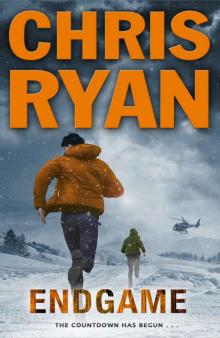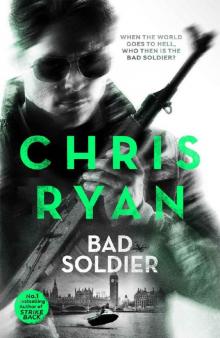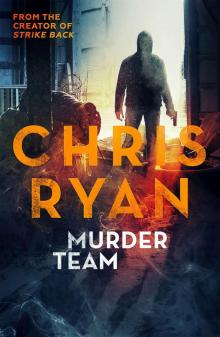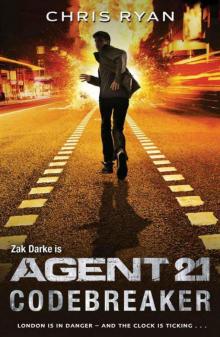- Home
- Chris Ryan
Stand By, Stand By gs-1 Page 4
Stand By, Stand By gs-1 Read online
Page 4
‘This last stretch before the Cray is bloody horrible. First there’s miles of moon grass, all tussocks. Then there’s this sod of a wood.’ I pointed to a triangular plantation cradled in a bowl of steep slopes. ‘It’s a hell of a long way round the wood, but going through it’s a bugger because of all the drainage ditches. So either way you’re in the shit. But, as I say, we won’t get that far today. What we’ll do is cross the road again at the AA box, here, and climb back over. Then we’ll go down through the woods to the reservoir, and the dam on which the route ends.’
‘Looks like some hike,’ said Tony.
‘It is. Even with our light loads it’ll take all day.’
We sorted our gear, locked the car and set off. As I expected, Tony moved easily, economically. He could have left me on the climbs, but that day we weren’t racing. Going up the steep lower flank of the Fan, we had no breath to spare for talking; Tony’s only utterance was one sudden, good-humoured outburst: ‘Nothing but rain, stone walls and goddam sheep!’
But then, as we came out on to the ridges, the weather began to break. The rain stopped, the clouds parted, and we started to see great green slopes sweeping away below us on either side. Our spirits lifted, and Tony set in to talk Spanish, slowly and methodically, asking questions about the landscape, describing things we could see. To my surprise, I found I could understand him pretty well, and answers came more easily than I’d expected. Alone with a good friend, and having no reason to feel embarrassed, I found that my confidence built quickly. All the lessons of the past few weeks began to fall into place, and at last the language was making sense. More than that, I found it a pleasure to use.
By the time we’d scrabbled our way up Jacob’s Ladder and reached the summit of the Fan the sun had come out, so we sat by the trig stone to eat our sandwiches. When Tony described the scenery as ‘real pretty’ I didn’t argue. I realized that, to him, used to the huge open spaces of America, the whole environment seemed dinky and small-scale — and on that hazy summer’s day the Brecons were looking their most serene. This, the highest point, might be only 3,000 feet above sea-level, but I knew what the hills could be like when they showed their teeth in the wind and sleet of a winter night. ‘The obelisk’s a memorial to a little boy who died up there one August,’ I said. ‘It was in 1900, and he was trying to cross from one farm to another when the fog came down. Tommy Jones, he was called. It was twenty-nine days before they found him, curled up in a hollow where the pillar now stands.’
From our vantage-point I explained how important it was to try to maintain our height on the way back across Fan Fawr, before the inevitable steep descent to the checkpoint by the AA box on the main road. ‘Thereafter, the route to trig-point 642 is really tough, an absolute ball-breaker: whichever way you go, you can’t avoid fierce climbs and drops.’
We could just make out 642 in the distance to the south. I told Tony that the stone bears a brass plaque in memory of Tony Swerzy, a member of the SAS killed on the Everest expedition of 1984.
And so we went on again, and kept going for the rest of that hazy summer afternoon.
* * *
Tony had been allotted a room in camp, but I suggested he might like to spend some nights in the cottage — an offer which he took up with alacrity. Apart from providing cheerful company, he raised culinary standards no end, as baked beans on toast gave way to steaming paella and chilli con carne. He had a heavy hand with the Tabasco, but that suited me fine, and one evening I was inspired to retaliate with the one sure weapon in my armoury, a curry as hot as Hades.
We went up to the Brecons several more times, and spent a couple of weekends walking some of the other routes, including Point-to-Point and Pipeline. We also went over the course for the Heavy Carry day — and with every outing I was improving my fluency in conversational Spanish.
The language course was a tough one, especially for guys like us who were used to a mainly physical existence. Our facilities were good — we had videos, audio-tapes and a separate audio-lab for making tapes of our own if we wanted — but the hours were long, and the lessons demanded a high level of concentration. We kicked off at 9.00 a.m., with the desks in the classroom set out in a horseshoe shape. Round the walls were big posters illustrating various weapons and armoured vehicles, with captions and statistics in Spanish. The poncified major in the Education Corps taught us grammar, and later in the mornings a Colombian professor would come up from Cardiff University to give us conversation. She’d chat to each of us in turn, starting off with ‘Buenos dios. ¿Tiene hora?’ and we’d answer, ‘Si, señora, son las doce menos cuatro,’ or whatever. The woman was a fearsome age, and knee-high to a piss-pot, but she had a great sense of humour, and generally turned the conversation into areas of interest to us: ‘¿Hay un bar por aquí?’ and so on.
By 12.30 everyone would be desperate to clear their heads, so it was into shorts, singlets and trainers and away for a run, five or six miles round the lanes at the back of the camp. On wet days some of the guys preferred a session on the weights in the gym. Then a quick shower, into DPMs again, and a dash down to the NAAFI for a sandwich or a pie, before being back into the classroom for 2 o’clock. By about 3.30 I’d see some of the guys dozing off. They’d have their heads propped in their hands, ostensibly concentrating like hell on their books, but then suddenly a hand would slip and a head would lurch downwards, and the owner would wake up with a start. By the time classes ended at 4.30, we’d all had enough — but then we had a pile of homework to take back with us.
* * *
Several months previously I’d applied to go on the Northern Ireland course, and now, one morning after Prayers in the Squadron Interest Room, the SSM said, ‘Right, as soon as we’re finished here, I want to see the following in my office.’ He read out a list of names, and mine was on it.
In we went, one at a time. Tom was sitting at his desk in one corner of the little room, and the squadron clerk was pattering away at his word-processor in the other.
‘OK, Geordie,’ the SSM began. ‘You want to go to the NI Troop?’
‘Right.’
‘We’ve got you down for troop training, starting July twentieth. You OK with that?’
‘Yep. That’s fine.’
‘Good. You want to get yourself down to see Johnny Hopton, who’s running the course. Find out if there’s any particular preparation you can do beforehand. Are you happy with that?’
‘That’s fine.’
‘Right, then. You start on the twentieth.’
I went out feeling chuffed to bollocks. Everyone wanted to get on the NI course, because a posting to Ulster meant live operations, rather than the endless training which otherwise was the Regiment’s lot in peacetime. Ulster meant danger, excitement and the chance to take on a real enemy. I knew that the posting was partly a question of seniority — the head-shed probably needed a couple of sergeants on the course — but I also knew they must have got together and talked about possible candidates, and I was glad to know they hadn’t been put off by my low patch after the Gulf.
The idea of a tour in Northern Ireland naturally made me think more than ever of Kath and Tim. What would happen if they were in Belfast and I got posted there? Would I be able to go and visit them, or would they be out of bounds? The possibility was way off, but I checked — and the answer was that, yes; guys in the troop were allowed to make social visits, provided the area was safe.
The training course would last four months. As I thought of my family, that suddenly began to seem a long time. I found I was missing them, and began to wonder if I should ask Kath to come back. Her mother had had her hip operation in the Musgrave, and it had been a success. The hospital had sent her home after only a week, and Kath’s presence had turned out to be a bit of a godsend. But now that Meg was almost fully mobile again, and out of pain, there was no reason from her point of view why Kath shouldn’t come home.
I would have to admit to everyone — Kath, her parents, and above all mysel
f — that I’d made a big mistake. It wasn’t exactly a question of swallowing my pride; I didn’t feel proud at all — anything but. Rather, it was a question of being certain that I wasn’t going to make things worse by dragging Kath and Tim home. If they did come back, and I got posted across the water, we’d be separated again anyway for the whole year of the tour… The permutations went round and round in my mind. Take action? Or wait some more?
* * *
When we sat our final test on the Spanish course, my confidence had built up to a new high, largely because of Tony. Thanks to our conversations, not even the prospect of giving a lecture to the rest of the course could faze me. I stood up and talked for three minutes about the relative merits of Real Madrid and Arsenal as if I was the greatest soccer pundit on the Costa. Besides the talk, we had to answer questions about a video we’d been shown, act as interpreter in a conversation between a Colombian woman and a third party, and write a description of our favourite holiday resort. I chose Corfu, and gave it the works. Next morning, I was amazed to see my name at the top of the list of passes.
That night I phoned Kath and told her the news. She sounded bright and lively, full of the joys of summer. They’d been out somewhere along the coast, and Tim had been paddling in the sea. He was talking a lot now, and he’d been asking where his dad was.
As she talked, the idea I’d been holding back for weeks swept over me. On impulse I said, ‘Listen, Kath. How about coming back?’
I heard her draw in her breath. There was a pause.
‘Why not try it?’ I urged.
Then she said, ‘Geordie! You mean it?’
‘Of course. I’m a whole lot better. I’m back to normal. Off the booze altogether. Things don’t seem right without you.’
She must have burst into tears. Half a minute passed, and I could hear snuffling sounds.
‘Kath — are you there?’
‘Yes. Geordie?’
‘What?’
‘I’m dying to see you.’
‘Great! Come on over, then.’
‘Of course I’ll come. But listen.’
‘What?’
I heard her blow her nose. ‘Mum’s had to go back into hospital. She’s been getting pain down her leg. We’re hoping it’s nothing serious, but the implant could have shifted, and they want her in for a few days’ observation. I’ve told her I’ll be here to look after her when she comes out. I won’t be able to make it for a couple of weeks.’
‘Not to worry. I can wait. As long as I know you’re on your way.’
‘Have you pinched the tops off the beans yet?’
‘Yes,’ I said, telling a white lie. ‘I did that.’
‘Brilliant,’ she said. ‘Lots of love, Geordie.’
‘Same to you.’
As soon as I put the phone down, I whipped out into the vegetable patch. Jesus, I thought, I’ve boobed here. The fucking beans were nearly up to my shoulder and covered with big white flowers! The smell was enough to stop you in your tracks. What was I supposed to do? Pick the flowers off? No — that would take forever. ‘Pinch the tops off,’ she’d said. But where did the top begin? What was top and what was stalk? There seemed to be bunches of buds all the way up. In the end I thought, To hell with it, and went along the rows nipping four or five inches off the top of each plant, and hoping the damn things would survive.
THREE
The NI course was an eye-opener to all twelve of us who took it. Most of it happened at the Llangwern Army Training Area, known as LATA, just a few miles into Wales. Because it was so close, we carried on living where we were, in and around camp, and drove there and back every day.
On the first morning we went down in a coach, and spent the day getting issued with all manner of fancy kit, not least cars. There was a pool of cars which lived at LATA, and they were handed out to us like toys — one to every two or three of us — for the duration of the course. I was given the keys of a dark-blue Cavalier, which I shared with Pat Martin. Like all the other cars, it was quite a sporty beast but inconspicuous; that was the point — it was fast enough to get us out of trouble but didn’t stand out or attract attention. The guy who handed it over told me I would be responsible for maintaining it in good nick, and for bringing it into the MT section if any problem needed sorting out. Then he added, ‘This one goes all right — but wait till you get across the water and try the intercept cars. They’re something else.’
The other goodies we got on day one included our waistcoats — one operational, one for civilian clothes. The ops waistcoat was designed to keep everything off the wearer’s legs: it had pockets for radio, spare magazines and grenades, and a built-in holder for a secondary weapon, the handgun. There were also places for plasticuffs and torches — all the little knick-knacks — and inside pockets to hold your orange armband and baseball cap with ARMY written on it, so that in any contact you could instantly turn yourself into a member of the security forces.
The civilian waistcoat had a place for a covert radio, which you worked with a small earpiece, a mike taped to your chest, and a pressel switch in one pocket, so that you could communicate without appearing to move. The drill was to carry a pistol — probably a Walther PPK, generally known as your disco gun — about your person. If you wore a T-shirt next to the skin and another shirt over it, a bit loose, nobody would spot anything.
Most of LATA lay on one side of a main road, shielded from passing traffic by a high wire fence and an evergreen hedge. As somebody gleefully pointed out, the designers of the fence had screwed up, tilting the two-foot overhang of barbed wire inwards rather than outwards, as if its function was to stop people getting out, rather than vice-versa. ‘It’s like it used to be in East Fucking Germany,’ said Pat as he surveyed it contemptuously. ‘Anything to stop the bastards getting out.’
Pat was like that. A big, solidly built fellow, much into weight-lifting, he had ruddy cheeks and brown eyes as shiny as horse-chestnuts. He was forever laughing and joking, and never failed to come up with some cheerfully obscene comment — a typical Cockney, always ready with a blast of effing-this and effing-that, enough to startle strangers. Whenever faced with a surprise or setback, his verbal reaction was so explosive that people who didn’t know him thought he was volatile and highly-strung. But really that was just his way of letting off steam, and underneath he was as solid as a rock.
His bulk was deceptive, too. At your first sight of him you might think he was muscle-bound. Far from it — he could do 100 metres in 11 seconds, as well as being able to throw small guys over walls and suchlike — a very useful attribute when you’re on the counter-terrorist team and things get physical. He and I hadn’t had much to do with each other before the course, but at LATA we teamed up and found we could work well as a pair.
The training area itself consisted largely of rough fields running up to meet Prescott’s Wood, a big stand of trees that covered the sides and top of a rounded hill, with a road winding through it, ideal for ambushes and illegal VCPs (vehicle control points). The fields looked more or less like neglected farmland, but they included a few surprises. There were several ranges, outdoors and in. The Garaback, for instance, was a two-storey building which had the walls of its rooms lined with steel sheets and rubber matting, so that live rounds would go through the rubber and drop down without ricocheting.
The course began gently with sessions on lock-picking. These took place in a special room packed with locks of every kind — doorlocks, padlocks, everything — plus a key-cutting machine, for us to use to manufacture our own. Outside we learnt to open cars with a slim jim, a long sliver of metal like a ruler, with hooks on it and small sections cut out.
Something else new to me was photography. We were taught to use cameras with short-focus lenses, for recording serial numbers of weapons and suchlike, and also telephoto monsters, for taking covert long-range pictures of people who might be players. We developed, printed and blew up our own shots in the darkroom on site.
At the
same time, we did exercises like Kim’s game, in which we were each given a bunch of mug-shots to study, and then, in a live parade, asked to identify any of the faces we’d been looking at. It was drummed into us that our lives might depend on recognizing a key player at a key moment.
A more active pursuit was fast driving, for which the police came down and took us out one-to-one. Most of us were already pretty competent, but we all got sharpened up. We put in big mileage on narrow country roads, such as we’d be using in Ireland, and learned to drive fast but safely. Then they took us to a big municipal car-park, empty in the early hours of the morning, where we used vehicles fitted with a special attachment — a frame which was mounted under the car, like a cradle on small wheels, with hydraulic controls that enabled the instructor to take most of the weight off the tyres. My teacher had a dial with a scale of one to five, and at five the Cavalier became like a turd on black ice, spinning at the slightest provocation. Here we learnt J-turns, yanking on the handbrake to spin the car in its own length.
The best session, though, was on the morning the police took us to a breaker’s yard and we bought a load of old bangers for about £50 apiece, to practise ramming. To get out of an illegal VCP or knock a hostile vehicle off the road you need to know what you’re doing, and for half a day we behaved like lunatics in full-sized dodgems, hammering the shit out of each other.
Another big issue was weaponry, principally the G3s, the Heckler & Koch 7.62mm rifles which are the standard weapon in Northern Ireland. With a magazine holding twenty rounds, and an excellent mechanism that hardly gives any stoppages, the G3 is ideal for firing into cars, since its penetration is far greater than that of the lower-powered Armalite. The longs (rifles are known as ‘longs’, pistols as ‘shorts’) at LATA were numbered with white paint on the butt, and I got No. 7, which I always reckon is lucky for me. Each of us also got an HK 53, a smaller, neater rifle, 556 calibre, good for tucking under the front seat of a car; and a Sig — properly a Sigsauer P 226 — a 9mm pistol, accurate and reliable, and not prone to stoppages. We were told to carry weapons on exercises, just to get used to them, but at night they went into a lock-up in a classroom, and it was the duty-sergeant’s job to make certain they were secure.

 Global Strike
Global Strike Hijack
Hijack Special Forces Cadets 2
Special Forces Cadets 2 Ruthless
Ruthless Manhunter
Manhunter Special Forces Cadets 1
Special Forces Cadets 1 Red Strike
Red Strike Black Ops
Black Ops Agent 21: The Wire
Agent 21: The Wire Land of Fire
Land of Fire Alpha Force: Fault Line
Alpha Force: Fault Line Under Cover (Agent 21)
Under Cover (Agent 21) Endgame (Agent 21)
Endgame (Agent 21) Red Centre
Red Centre Blackout
Blackout Killing for the Company
Killing for the Company The Watchman
The Watchman Osama
Osama Who Dares Wins
Who Dares Wins The Kremlin Device
The Kremlin Device Hunter Killer
Hunter Killer Alpha Force: Untouchable
Alpha Force: Untouchable Stand By Stand By
Stand By Stand By Chris Ryan Extreme: Hard Target: Mission Four: Fallout
Chris Ryan Extreme: Hard Target: Mission Four: Fallout Greed mb-1
Greed mb-1 Alpha Force: Desert Pursuit
Alpha Force: Desert Pursuit Strike Back
Strike Back Greed
Greed The Bay Bulls Standoff
The Bay Bulls Standoff Stand By, Stand By gs-1
Stand By, Stand By gs-1 Outbreak
Outbreak Hunted
Hunted Vortex cr-4
Vortex cr-4 Rat-Catcher
Rat-Catcher Vortex
Vortex Bad Soldier
Bad Soldier Shadow Kill: A Strikeback Novel
Shadow Kill: A Strikeback Novel Murder Team (Kindle Single)
Murder Team (Kindle Single) One Good Turn
One Good Turn Flash Flood cr-1
Flash Flood cr-1 Night Strike
Night Strike Wildfire
Wildfire Agent 21: Reloaded: Book 2
Agent 21: Reloaded: Book 2 Chris Ryan Extreme: Hard Target: Mission Two: The Rock
Chris Ryan Extreme: Hard Target: Mission Two: The Rock Masters of War
Masters of War Murder Team
Murder Team War Dog
War Dog Wildfire cr-2
Wildfire cr-2 Survival
Survival The One That Got Away - Junior edition
The One That Got Away - Junior edition The Hit List
The Hit List The Kill Zone
The Kill Zone Medal of Honor
Medal of Honor Battleground
Battleground Twister
Twister Tenth Man Down gs-4
Tenth Man Down gs-4 The Kremlin Device gs-3
The Kremlin Device gs-3 Hostage
Hostage Bad Soldier: Danny Black Thriller 4
Bad Soldier: Danny Black Thriller 4 Alpha Force: Blood Money
Alpha Force: Blood Money Firefight
Firefight Chris Ryan Extreme: Hard Target: Mission One: Redeemer
Chris Ryan Extreme: Hard Target: Mission One: Redeemer Hit List
Hit List Zero Option gs-2
Zero Option gs-2 Black Gold
Black Gold Agent 21: Codebreaker: Book 3
Agent 21: Codebreaker: Book 3 Zero Option
Zero Option Ultimate Weapon
Ultimate Weapon Tenth Man Down
Tenth Man Down Twister cr-5
Twister cr-5 Deathlist
Deathlist Hellfire
Hellfire Flash Flood
Flash Flood Battleground cr-6
Battleground cr-6 The Increment
The Increment